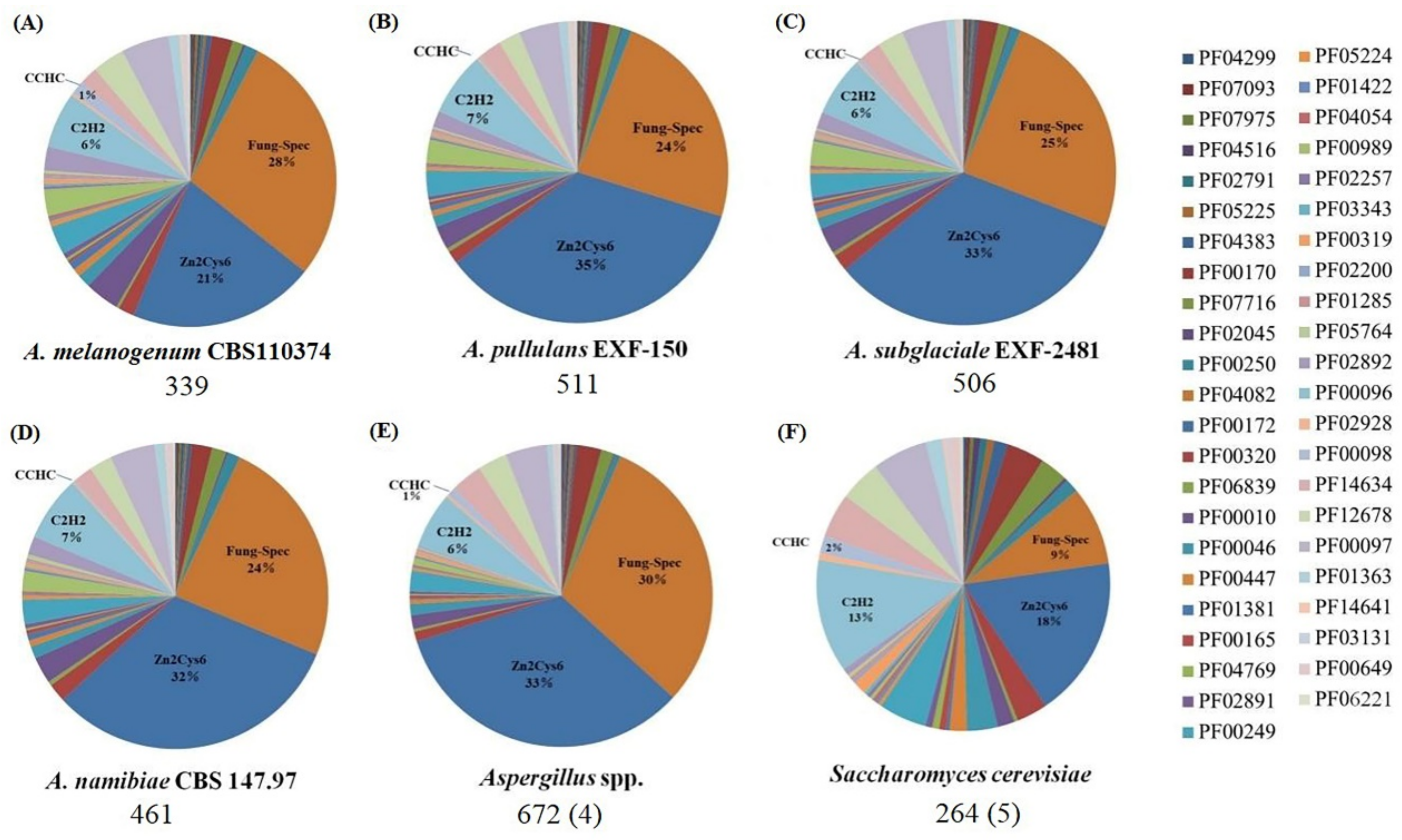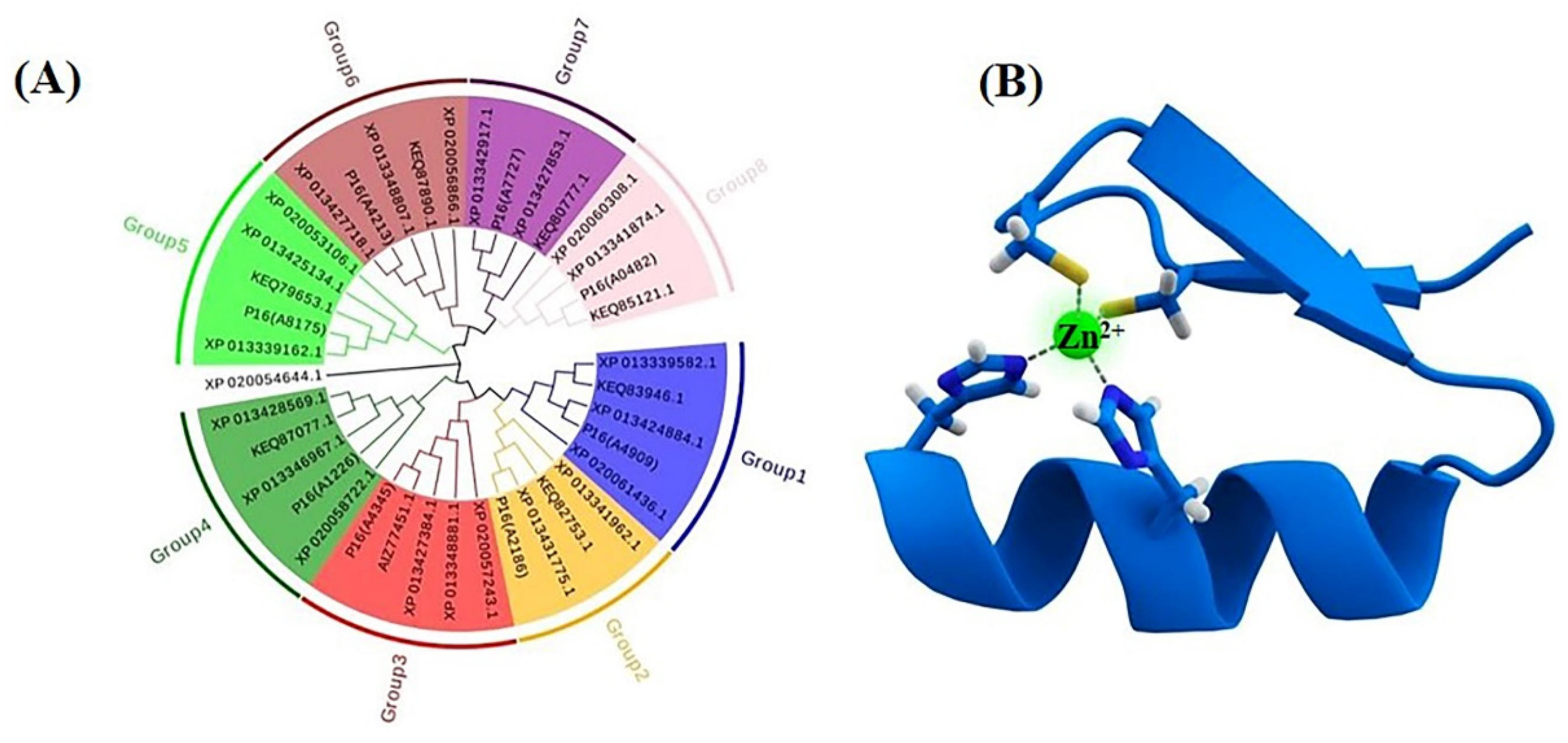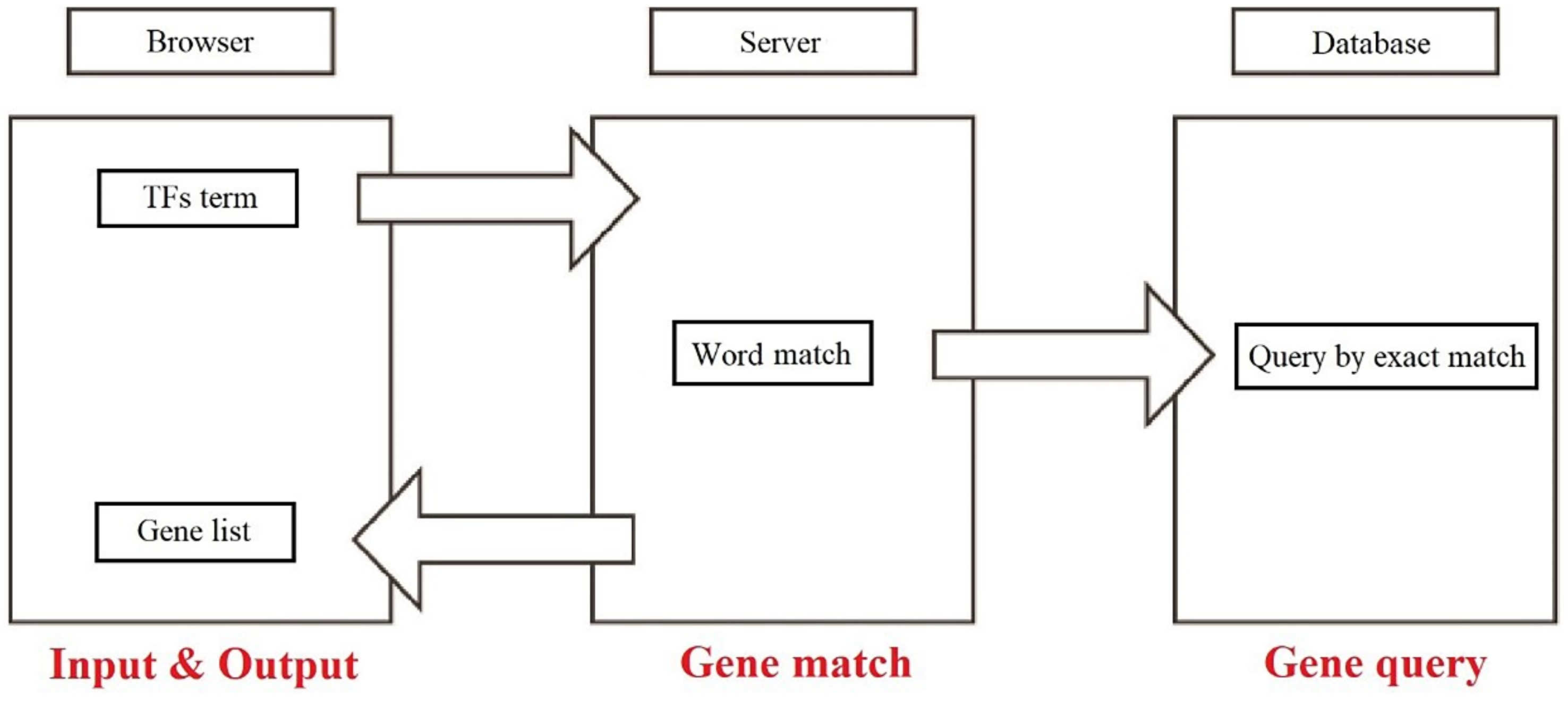Transcription Factors in Aureobasidium spp.: Classification, Regulation and a Newly Built Database
Abstract
:1. Introduction
2. Methods
2.1. Genome Collection and Data Analysis
2.2. Homologues TFs Searches and Training
2.3. Function Annotation and Domain Analysis
2.4. Compilation of the TF Genes
2.5. TFs Classification between the NCBI and Transcription Factor Database
2.6. Database Construction
3. Results and Discussion
3.1. PFAM Families of DNA-Binding Domains in Aureobasidium spp.
3.2. The Zn2Cys6 and Fungal-Specific TF Families
3.2.1. The Zinc Cluster TF Families
3.2.2. The “Fungal-Specific Transcription Factor Domain” TF Families
3.2.3. The KilA-N Domain TF Families
3.2.4. The HMG-Box Domain TF Families
3.2.5. The HTH, Basic Leu Zipper (bZip) and Forkhead (FH) TF Families
3.3. Identification of Transcription Factors in Aureobasidium spp.
3.3.1. Taxonomy and Functions of the Zinc Finger TFs in Aureobasidium spp.
3.3.2. Classification and Functions of the C2H2 TFs in Aureobasidium spp.
3.4. Transcription Factor Database for Aureobasidium spp.
3.5. Advantages of the ATFDB over Other Orthology Databases
4. Conclusions
Supplementary Materials
Author Contributions
Funding
Institutional Review Board Statement
Informed Consent Statement
Data Availability Statement
Conflicts of Interest
References
- Jia, S.L.; Chi, Z.; Liu, G.L.; Hu, Z.; Chi, Z.M. Fungi in mangrove ecosystems and their potential applications. Crit. Rev. Biotechnol. 2020, 40, 852–864. [Google Scholar] [CrossRef]
- Zhang, M.; Gao, Z.C.; Chi, Z.; Liu, G.L.; Hu, Z.; Chi, Z.M. cAMP-PKA and HOG1 signaling pathways regulate liamocin production by different ways via the transcriptional activator Msn2 in Aureobasidium melanogenum. Enzyme Microb. Technol. 2021, 143, 109705. [Google Scholar] [CrossRef] [PubMed]
- Wang, K.; Chi, Z.; Liu, G.L.; Qi, C.Y.; Jiang, H.; Hu, Z.; Chi, Z.M. A novel PMA synthetase is the key enzyme for polymalate biosynthesis and its gene is regulated by a calcium signaling pathway in Aureobasidium melanogenum ATCC62921. Int. J. Biol. Macromol. 2020, 156, 1053–1063. [Google Scholar] [CrossRef] [PubMed]
- Xue, S.J.; Chen, L.; Jiang, H.; Liu, G.L.; Chi, Z.M.; Hu, Z.; Chi, Z. High pullulan biosynthesis from high concentration of glucose by a hyperosmotic resistant, yeast-like fungal strain isolated from a natural comb-honey. Food Chem. 2019, 286, 123–128. [Google Scholar] [CrossRef] [PubMed]
- Wang, M.; Danesi, P.; James, T.Y.; Al-Hatmi, A.; Najafzadeh, M.J.; Dolatabadi, S.; Ming, C.; Liou, G.Y.; Kang, Y.; de Hoog, S. Comparative pathogenicity of opportunistic black yeasts in Aureobasidium. Mycoses 2019, 62, 803–811. [Google Scholar] [PubMed]
- Aung, T.; Jiang, H.; Liu, G.L.; Chi, Z.; Hu, Z.; Chi, Z.M. Overproduction of a beta-fructofuranosidase1 with a high FOS synthesis activity for efficient biosynthesis of fructooligosaccharides. Int. J. Biol. Macromol. 2019, 130, 988–996. [Google Scholar] [CrossRef] [PubMed]
- Yang, G.; Liu, G.L.; Wang, S.J.; Chi, Z.M.; Chi, Z. Pullulan biosynthesis in yeast-like fungal cells is regulated by the transcriptional activator Msn2 and cAMP-PKA signaling pathway. Int. J. Biol. Macromol. 2020, 157, 591–603. [Google Scholar] [CrossRef]
- Slj, A.; Zhe, C.; Lu, C.; Glla, B.; Zhong, H.C.; Zmca, B. Molecular evolution and regulation of DHN melanin-related gene clusters are closely related to adaptation of different melanin-producing fungi. Genomics 2021, 113, 1962–1975. [Google Scholar]
- Shelest, E. Transcription factors in fungi. FEMS Microbiol. Lett. 2008, 286, 145–151. [Google Scholar] [CrossRef] [Green Version]
- Drobna, E.; Bialkova, A.; Subik, J. Transcriptional regulators of seven yeast species: Comparative genome analysis. Review. Folia Microbiol. 2008, 53, 275–287. [Google Scholar] [CrossRef]
- Shelest, E. Transcription factors in fungi: Tfome dynamics, three major families, and dual-specificity TFs. Front. Genet. 2017, 8, 53. [Google Scholar] [CrossRef]
- Grigoriev, I.V.; Nikitin, R.; Haridas, S.; Kuo, A.; Ohm, R.; Otillar, R.; Riley, R.; Salamov, A.; Zhao, X.; Korzeniewski, F.; et al. Mycocosm portal: Gearing up for 1000 fungal genomes. Nucleic Acids Res. 2014, 42, D699–D704. [Google Scholar] [CrossRef]
- Kang, X.X.; Jia, S.L.; Wei, X.; Zhang, M.; Liu, G.L.; Hu, Z.; Chi, Z.; Chi, Z.M. Liamocins biosynthesis, its regulation in Aureobasidium spp., and their bioactivities. Crit. Rev. Biotechnol. 2022, 42, 93–105. [Google Scholar] [CrossRef]
- Wei, X.; Liu, G.L.; Jia, S.L.; Chi, Z.; Hu, Z.; Chi, Z.M. Pullulan biosynthesis and its regulation in Aureobasidium spp. Carbohydr. Polym. 2021, 251, 117076. [Google Scholar] [CrossRef]
- Macpherson, S.; Larochelle, M.; Turcotte, B. A fungal family of transcriptional regulators: The zinc cluster proteins. Microbiol. Mol. Biol. R. 2006, 70, 583–604. [Google Scholar] [CrossRef] [Green Version]
- Gostincar, C.; Turk, M.; Zajc, J.; Gunde-Cimerman, N. Fifty Aureobasidium pullulans genomes reveal a recombining polyextremotolerant generalist. Environ. Microbiol. 2019, 21, 3638–3652. [Google Scholar] [CrossRef] [Green Version]
- Gostincar, C.; Ohm, R.A.; Kogej, T.; Sonjak, S.; Turk, M.; Zajc, J.; Zalar, P.; Grube, M.; Sun, H.; Han, J.; et al. Genome sequencing of four Aureobasidium pullulans varieties: Biotechnological potential, stress tolerance, and description of new species. BMC Genom. 2014, 15, 549. [Google Scholar] [CrossRef] [Green Version]
- Jia, S.L.; Ma, Y.; Chi, Z.; Liu, G.L.; Chi, Z.M. Genome sequencing of a yeast-like fungal strain P6, a novel species of Aureobasidium spp.: Insights into its taxonomy, evolution, and biotechnological potentials. Ann. Microbiol. 2019, 69, 1475–1488. [Google Scholar] [CrossRef]
- Yang, G.; Cui, X.; Liu, S.; Lu, J.; Fang, Y. Effects of dietary Lactobacillus helveticus on the growth rate, disease resistance and intestinal health of pond loach (Misgurnus anguillicaudatus). Aquaculture 2021, 544, 737038. [Google Scholar] [CrossRef]
- Tsang, L.M.; Ming, L.; Shen, X.; Cheang, C.C.; Chu, K.H.; Chan, B.K.K. Gene rearrangement and sequence analysis of mitogenomes suggest polyphyly of archaeobalanid and balanid barnacles (Cirripedia: Balanomorpha). Zool. Scr. 2017, 46, 729–739. [Google Scholar] [CrossRef]
- Liu, F. Chloroplast genome of Sargassum horneri (Sargassaceae, Phaeophyceae): Comparative chloroplast genomics of brown algae. J. Appl. Phycol. 2016, 28, 1419–1426. [Google Scholar] [CrossRef]
- Shen, X.; Ling, M.T.; Chu, K.H.; Achituv, Y.; Chan, B. Mitochondrial genome of the intertidal acorn barnacle Tetraclita serrata Darwin, 1854 (Crustacea: Sessilia): Gene order comparison and phylogenetic consideration within Sessilia. Mar. Genom. 2015, 22, 63–69. [Google Scholar] [CrossRef] [PubMed]
- Lu, Y.; Liu, G.; Jiang, H.; Chi, Z.; Chi, Z. An insight into the iron acquisition and homeostasis in Aureobasidium melanogenum HN6.2 strain through genome mining and transcriptome analysis. Funct. Integr. Genom. 2019, 19, 137–150. [Google Scholar] [CrossRef] [PubMed]
- Todd, R.B.; Zhou, M.; Ohm, R.A.; Leeggangers, H.A.; Visser, L.; de Vries, R.P. Prevalence of transcription factors in ascomycete and basidiomycete fungi. BMC Genom. 2014, 15, 214. [Google Scholar] [CrossRef] [Green Version]
- Jiang, H.; Chi, Z.; Liu, G.L.; Hu, Z.; Zhao, S.Z.; Chi, Z.M. Melanin biosynthesis in the desert-derived Aureobasidium melanogenum XJ5-1 is controlled mainly by the CWI signal pathway via a transcriptional activator Cmr1. Curr. Genet. 2020, 66, 173–185. [Google Scholar] [CrossRef]
- Amoutzias, G.D.; Veron, A.S.; Weiner, J.R.; Robinson-Rechavi, M.; Bornberg-Bauer, E.; Oliver, S.G.; Robertson, D.L. One billion years of bZIP transcription factor evolution: Conservation and change in dimerization and DNA-binding site specificity. Mol. Biol. Evol. 2007, 24, 827–835. [Google Scholar] [CrossRef] [Green Version]
- Hahn, J.S.; Hu, Z.; Thiele, D.J.; Iyer, V.R. Genome-wide analysis of the biology of stress responses through heat shock transcription factor. Mol. Cell. Biol. 2004, 24, 5249–5256. [Google Scholar] [CrossRef] [Green Version]
- Krishna, S.S.; Majumdar, I.; Grishin, N.V. Structural classification of zinc fingers: Survey and summary. Nucleic Acids Res. 2003, 31, 532–550. [Google Scholar] [CrossRef] [Green Version]
- Wang, Q.Q.; Lu, Y.; Ren, Z.Y.; Chi, Z.; Liu, G.L.; Chi, Z.M. CreA is directly involved in pullulan biosynthesis and regulation of Aureobasidium melanogenum P16. Curr. Genet. 2017, 63, 471–485. [Google Scholar] [CrossRef]
- Gorner, W.; Durchschlag, E.; Martinez-Pastor, M.T.; Estruch, F.; Ammerer, G.; Hamilton, B.; Ruis, H.; Schuller, C. Nuclear localization of the C2H2 zinc finger protein Msn2p is regulated by stress and protein kinase A activity. Genes Dev. 1998, 12, 586–597. [Google Scholar] [CrossRef] [Green Version]
- Stathopoulos-Gerontides, A.; Guo, J.J.; Cyert, M.S. Yeast calcineurin regulates nuclear localization of the Crz1p transcription factor through dephosphorylation. Genes Dev. 1999, 13, 798. [Google Scholar] [CrossRef]
- van der Felden, J.; Weisser, S.; Bruckner, S.; Lenz, P.; Mosch, H.U. The transcription factors Tec1 and Ste12 interact with coregulators Msa1 and Msa2 to activate adhesion and multicellular development. Mol. Cell. Biol. 2014, 34, 2283–2293. [Google Scholar] [CrossRef] [Green Version]
- Borneman, A.R.; Hynes, M.J.; Andrianopoulos, A. An STE12 homolog from the asexual, dimorphic fungus Penicillium marneffei complements the defect in sexual development of an Aspergillus nidulans steA mutant. Genetics 2001, 157, 1003–1014. [Google Scholar] [CrossRef]
- Barda, O.; Maor, U.; Sadhasivam, S.; Bi, Y.; Zakin, V.; Prusky, D.; Sionov, E. The pH-responsive transcription factor PacC governs pathogenicity and ochratoxin a biosynthesis in Aspergillus carbonarius. Front. Microbiol. 2020, 11, 210. [Google Scholar] [CrossRef]
- Chiang, Y.M.; Szewczyk, E.; Davidson, A.D.; Keller, N.; Oakley, B.R.; Wang, C.C. A gene cluster containing two fungal polyketide synthases encodes the biosynthetic pathway for a polyketide, asperfuranone, in Aspergillus nidulans. J. Am. Chem. Soc. 2009, 131, 2965–2970. [Google Scholar] [CrossRef] [Green Version]
- Zhu, Z.; Labbe, S.; Pena, M.M.; Thiele, D.J. Copper differentially regulates the activity and degradation of yeast Mac1 transcription factor. J. Biol. Chem. 1998, 273, 1277–1280. [Google Scholar] [CrossRef] [Green Version]
- Eliahu, N.; Igbaria, A.; Rose, M.S.; Horwitz, B.A.; Lev, S. Melanin biosynthesis in the maize pathogen Cochliobolus heterostrophus depends on two mitogen-activated protein kinases, Chk1 and Mps1, and the transcription factor Cmr1. Eukaryot. Cell 2007, 6, 421–429. [Google Scholar] [CrossRef] [Green Version]
- Zhao, S.F.; Jiang, H.; Chi, Z.; Liu, G.L.; Chi, Z.M.; Chen, T.J.; Yang, G.; Hu, Z. Genome sequencing of Aureobasidium pullulans P25 and overexpression of a glucose oxidase gene for hyper-production of Ca2+-gluconic acid. Antonie Van Leeuwenhoek 2019, 112, 669–678. [Google Scholar] [CrossRef]
- Xue, S.J.; Chi, Z.; Zhang, Y.; Li, Y.F.; Liu, G.L.; Jiang, H.; Hu, Z.; Chi, Z.M. Fatty acids from oleaginous yeasts and yeast-like fungi and their potential applications. Crit. Rev. Biotechnol. 2018, 38, 1049–1060. [Google Scholar] [CrossRef]
- Qi, C.Y.; Jia, S.L.; Liu, G.L.; Chen, L.; Wei, X.; Hu, Z.; Chi, Z.M.; Chi, Z. Polymalate (PMA) biosynthesis and its molecular regulation in Aureobasidium spp. Int. J. Biol. Macromol. 2021, 174, 512–518. [Google Scholar] [CrossRef]
- Ma, Z.C.; Fu, W.J.; Liu, G.L.; Wang, Z.P.; Chi, Z.M. High-level pullulan production by Aureobasidium pullulans var. melanogenium P16 isolated from mangrove system. Appl. Microbiol. Biotechnol. 2014, 98, 4865–4873. [Google Scholar] [CrossRef]







| PFAM Family | PFAM ID |
|---|---|
| KilA-N domain | PF04383 |
| bZIP transcription factor (bZIP_1) | PF00170 |
| Putative FMN-binding domain | PF04299 |
| SGT1 protein | PF07093 |
| TFIIH C1-like domain | PF07975 |
| CP2 transcription factor | PF04516 |
| DDT domain | PF02791 |
| Helix–turn–helix, Psq domain | PF05225 |
| Basic region leucine zipper 2 | PF07716 |
| CCAAT-binding TF (CBF-B/NF-YA) subunit B | PF02045 |
| Forkhead domain | PF00250 |
| Fungal specific transcription factor domain | PF04082 |
| Fungal Zn(2)-Cys(6) binuclear cluster domain | PF00172 |
| GATA zinc finger | PF00320 |
| GRF zinc finger | PF06839 |
| Helix-loop-helix DNA-binding domain | PF00010 |
| Homeodomain (Homeobox) | PF00046 |
| HSF-type DNA-binding | PF00447 |
| Helix-turn-helix (HTH_3) | PF01381 |
| Bacterial regulatory helix-turn-helix proteins, AraC family | PF00165 |
| Mating-type protein MAT alpha 1 HMG-box | PF04769 |
| MIZ/SP-RING zinc finger | PF02891 |
| Myb-like DNA-binding domain | PF00249 |
| NDT80/PhoG-like DNA-binding family | PF05224 |
| NF-X1 type zinc finger | PF01422 |
| CCR4-Not complex component, Not1 | PF04054 |
| PAS fold | PF00989 |
| RFX DNA-binding domain | PF02257 |
| SART-1 family | PF03343 |
| SRF-type TF (DNA-binding and dimerization domain) | PF00319 |
| STE-like transcription factor | PF02200 |
| TEA/ATTS domain | PF01285 |
| YL1 nuclear protein | PF05764 |
| BED zinc finger | PF02892 |
| Zinc finger, C2H2 type | PF00096 |
| Zinc finger, C5HC2 type | PF02928 |
| Zinc knuckle(zf-CCHC) | PF00098 |
| Zinc-Ring finger domain | PF14634 |
| Ring-H2 zinc finger domain | PF12678 |
| Zinc finger, C3HC4 type (Ring finger) | PF00097 |
| FYVE zinc finger | PF01363 |
| Helix-turn-helix DNA-binding domain of SPT6 | PF14641 |
| bZIP Maf transcription factor | PF03131 |
| Copper fist DNA binding domain | PF00649 |
| Putative zinc finger motif, C2HC5-type | PF06221 |
| Superfamily | Superfamily ID |
| beta-beta-alpha zinc fingers (C2H2 and C2HC zinc fingers) | 57667 |
| DNA-binding domain of Mlu1-box-binding protein Mbp1 | 54616 |
| Glucocorticoid receptor-like (DNA-binding domain) | 57716 |
| Helix-loop-helix DNA-binding domain | 47459 |
| Homeodomain-like | 46689 |
| Lambda repressor-like DNA-binding domains | 47413 |
| Nucleic acid-binding proteins | 50249 |
| p53-like transcription factors | 49417 |
| SRF-like | 55455 |
| Winged helix DNA-binding domain | 46785 |
| Zinc domain conserved in yeast copper-regulated TFs | 57879 |
| Zn2/Cys6 DNA-binding domain | 57701 |
| HMG-box | 47095 |
| Putative DNA-binding domain | 46955 |
| basic-leucine zipper (bZIP) | 57959 |
| WD40 repeat-like | 50978 |
| Types | Family | Function |
|---|---|---|
| Zn2/Cys6 (Zn cluster) | Superfamily: 57701 | Galactose metabolism, proline utilization, nitrogen metabolism, sugar and amino acid metabolism, polysaccharide metabolism, ironophore biosynthesis, xylan/cellulose degradation, amylohydrolysis, regulation of secondary metabolite clusters. |
| DNA-binding domain of Mlu1-box-binding protein Mbp1 | Superfamily: 54616 | Cell cycle regulation |
| Basic-leucine zipper (bZIP) | Superfamily: 57959 | Metabolism of iron element, osmotic and oxidative stress reactions, regulation of HOG pathway, chromatin remodeling and nitrogen metabolism. |
| Zinc domain conserved in yeast copper-regulated TFs/Copper fist DNA binding domain | Superfamily: 57879 PFAM: PF00649 | Activation of the transcription of the metallothionein gene in response to copper |
| Fungal-specific transcription factor domain | PFAM: PF04082 | Sugar and amino acid metabolism, fatty acid catabolism and other cellular and metabolic processes |
| KilA-N domain | PFAM: PF04383 | Cell cycle, pseudohyphal differentiation, morphogenesis and metabolism. |
| Mating-type protein MAT alpha 1 HMG-box | PFAM: PF04769 | Activation of mating-type α-specific genes, bind cooperatively with Mcm1 to PQ elements upstream of α-specific genes |
| Helix-turn-helix (HTH_3) | PFAM: PF01381 | Regulation of RNA transcription |
| Helix-loop-helix DNA-binding domain | PFAM: PF00010 | Conidiospore regulation and pseudohyphal differentiation, phospholipid and fatty acid synthesis, chromatin remodeling. |
| Forkhead domain | PFAM: PF00250 | Chromatin silencing at HML and HMR, regulation of the G2/M phase gene expression |
Publisher’s Note: MDPI stays neutral with regard to jurisdictional claims in published maps and institutional affiliations. |
© 2022 by the authors. Licensee MDPI, Basel, Switzerland. This article is an open access article distributed under the terms and conditions of the Creative Commons Attribution (CC BY) license (https://creativecommons.org/licenses/by/4.0/).
Share and Cite
Yang, G.; Wang, Y.; Fang, Y.; Mo, H.; Hu, Z.; Hou, X.; Liu, S.; Chen, Z.; Jia, S. Transcription Factors in Aureobasidium spp.: Classification, Regulation and a Newly Built Database. J. Fungi 2022, 8, 1096. https://doi.org/10.3390/jof8101096
Yang G, Wang Y, Fang Y, Mo H, Hu Z, Hou X, Liu S, Chen Z, Jia S. Transcription Factors in Aureobasidium spp.: Classification, Regulation and a Newly Built Database. Journal of Fungi. 2022; 8(10):1096. https://doi.org/10.3390/jof8101096
Chicago/Turabian StyleYang, Guang, Yuhan Wang, Yaowei Fang, Hongjuan Mo, Zhihong Hu, Xiaoyue Hou, Shu Liu, Zhongwei Chen, and Shulei Jia. 2022. "Transcription Factors in Aureobasidium spp.: Classification, Regulation and a Newly Built Database" Journal of Fungi 8, no. 10: 1096. https://doi.org/10.3390/jof8101096





